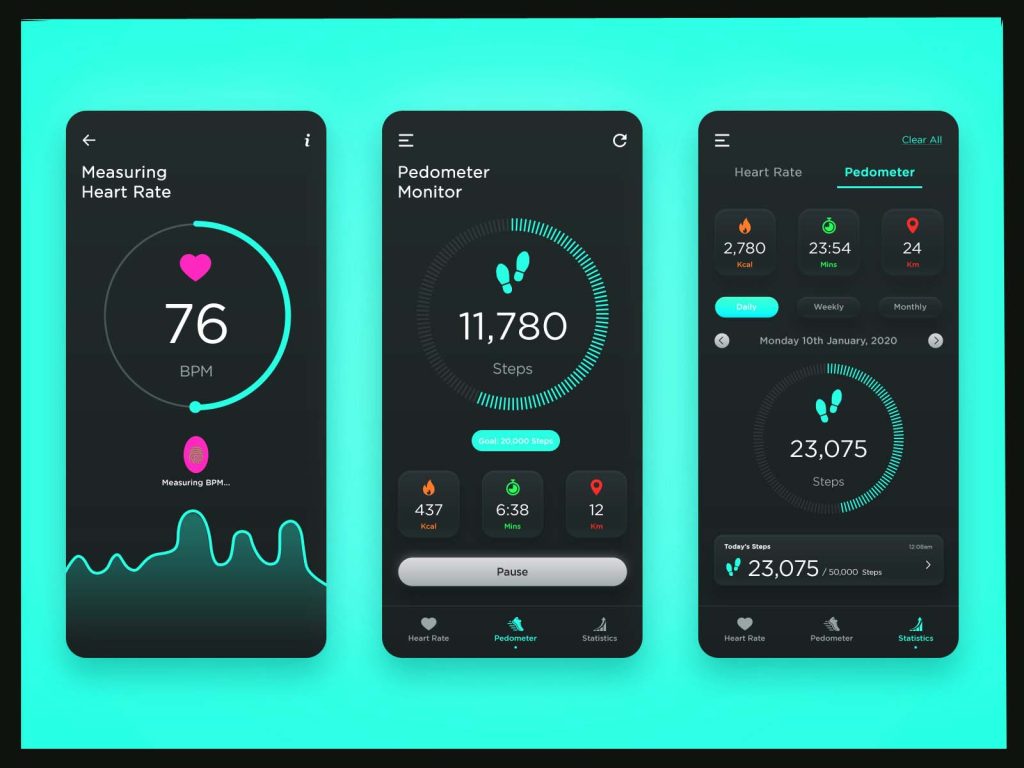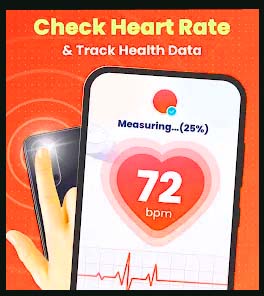

Mobile heart rate sensors:
Mobile heart rate sensors refer to the technology integrated into mobile devices, such as smartphones and wearable gadgets like smartwatches and fitness trackers, that enables the measurement of a person’s heart rate. These sensors use various methods to detect the user’s pulse and provide real-time or periodic updates on their heart rate. The primary purpose of mobile heart rate sensors is to offer users insights into their cardiovascular health and facilitate activities like fitness tracking, stress management, and sleep monitoring.
The most common technology used in mobile heart rate sensors is photoplethysmography (PPG). PPG sensors emit light into the skin, typically using LEDs, and measure changes in blood volume in the microvascular tissue. As blood flow varies with each heartbeat, the amount of light absorbed or reflected by the skin changes accordingly. By analyzing these changes, the sensor can calculate the user’s heart rate.
Features:
Here are some common features and functionalities associated with mobile heart rate sensors:
- Real-time Monitoring: Mobile heart rate sensors allow users to monitor their heart rate in real-time, providing instant feedback on their cardiovascular health.
- Accuracy: Manufacturers strive to improve the accuracy of heart rate sensors to provide reliable data to users. This includes minimizing errors and ensuring consistency across different situations and users.
- Integration with Health Apps: Many mobile heart rate sensor-equipped devices integrate with health and fitness apps, allowing users to track their heart rate data over time, set goals, and analyze trends.
- Workout Tracking: Some sensors include features specifically designed for tracking heart rate during workouts or physical activities. This can help users optimize their exercise routines and monitor their intensity levels.
- Resting Heart Rate: Devices often provide insights into resting heart rate, which can be an indicator of overall cardiovascular health and fitness level.
- Heart Rate Variability (HRV): Advanced sensors may measure heart rate variability, which is the variation in the time interval between heartbeats. HRV is associated with stress levels, fitness, and overall well-being.
- Sleep Tracking: Some devices with heart rate sensors offer sleep tracking capabilities, providing insights into sleep quality and patterns based on changes in heart rate throughout the night.
- Alerts and Notifications: Devices may offer alerts or notifications when the user’s heart rate exceeds or falls below predefined thresholds. This can be useful for monitoring health conditions or ensuring safe exercise intensity.
- Continuous Monitoring: Certain devices support continuous heart rate monitoring throughout the day, providing a comprehensive overview of the user’s heart rate patterns and behavior.
- ECG Monitoring: High-end devices may feature electrocardiogram (ECG or EKG) capabilities, allowing users to record and analyze the electrical activity of their heart. This feature can provide more detailed insights into heart health, including detecting irregular heart rhythms such as atrial fibrillation.
- Water Resistance: For wearable devices, water resistance is an important feature, allowing users to wear them during activities like swimming or intense workouts without worrying about damage to the sensor.
- Battery Life: Efficient power management is crucial for devices with heart rate sensors, ensuring extended battery life to support continuous monitoring without frequent recharging.
These features collectively provide users with valuable insights into their cardiovascular health and help them make informed decisions about their fitness, wellness, and overall lifestyle.
Advantages:
Mobile heart rate sensors offer several advantages, making them valuable tools for individuals interested in monitoring their cardiovascular health, fitness enthusiasts, and healthcare professionals. Here are some of the key advantages:
- Convenience: One of the primary advantages of mobile heart rate sensors is their convenience. They are integrated into devices that people typically carry with them everywhere, such as smartphones or wearable devices like smartwatches. This accessibility allows users to monitor their heart rate conveniently and regularly without the need for additional specialized equipment.
- Real-time Monitoring: Mobile heart rate sensors provide real-time feedback on heart rate, allowing users to monitor changes instantly. This instantaneous feedback is particularly useful during exercise sessions, allowing individuals to adjust their intensity levels accordingly for optimal performance or safety.
- Fitness Tracking: For fitness enthusiasts, mobile heart rate sensors offer valuable insights into workout intensity and calorie burn. By tracking heart rate during exercise, users can gauge the effectiveness of their workouts, optimize training regimens, and set realistic fitness goals.
- Health Monitoring: Beyond fitness tracking, mobile heart rate sensors serve as important tools for monitoring overall health. Regular heart rate monitoring can help individuals detect irregularities or abnormalities in heart rhythm, potentially indicating underlying cardiovascular issues. Early detection of such issues can prompt timely medical intervention and treatment, potentially preventing more serious complications.
- Stress Management: Heart rate variability (HRV) monitoring, offered by some mobile heart rate sensors, provides insights into the body’s response to stress. By tracking changes in HRV, users can better understand their stress levels and implement strategies for stress management, such as relaxation techniques or mindfulness practices.
- Sleep Tracking: Many mobile heart rate sensors include sleep tracking capabilities, allowing users to monitor their heart rate patterns during sleep. This data can help individuals assess the quality of their sleep, identify sleep disturbances, and make lifestyle adjustments to improve overall sleep health.
- Accessibility: Mobile heart rate sensors make heart rate monitoring accessible to a wide range of users, including those who may not have easy access to traditional medical equipment or facilities. This accessibility democratizes healthcare by empowering individuals to take a proactive approach to their cardiovascular health.
- Cost-effective: Compared to dedicated medical devices or professional monitoring services, mobile heart rate sensors are often more cost-effective. Many individuals already own smartphones or wearable devices with built-in heart rate sensors, eliminating the need for additional purchases.
- Integration with Health Apps: Mobile heart rate sensors often integrate seamlessly with health and fitness apps, allowing users to consolidate their health data in one place. This integration enables comprehensive health tracking and analysis, facilitating informed decision-making regarding lifestyle choices and health goals.
Overall, mobile heart rate sensors offer numerous advantages, ranging from convenience and accessibility to health monitoring and fitness tracking. By leveraging these sensors, individuals can gain valuable insights into their cardiovascular health and well-being, empowering them to make informed decisions to support a healthier lifestyle.
